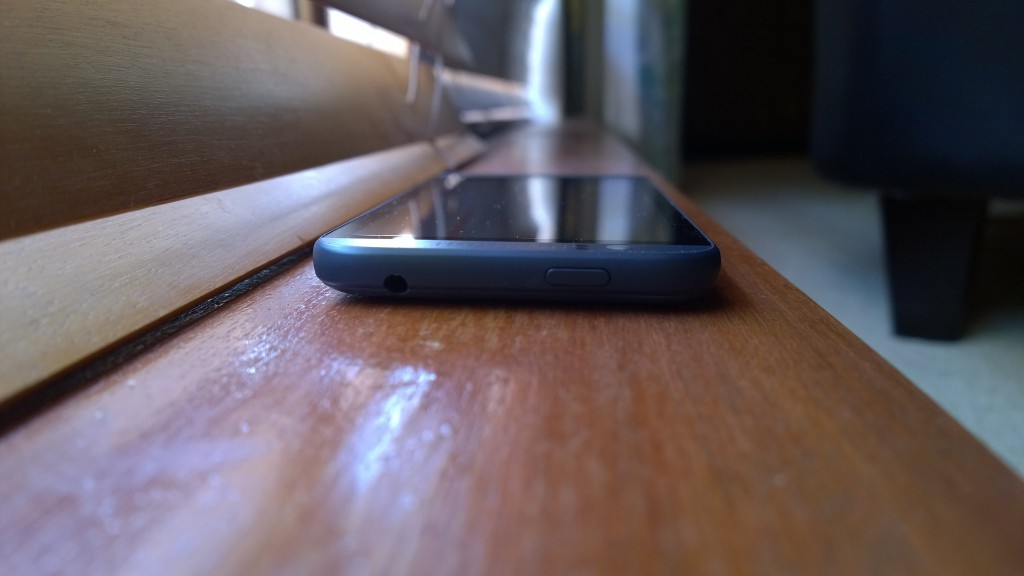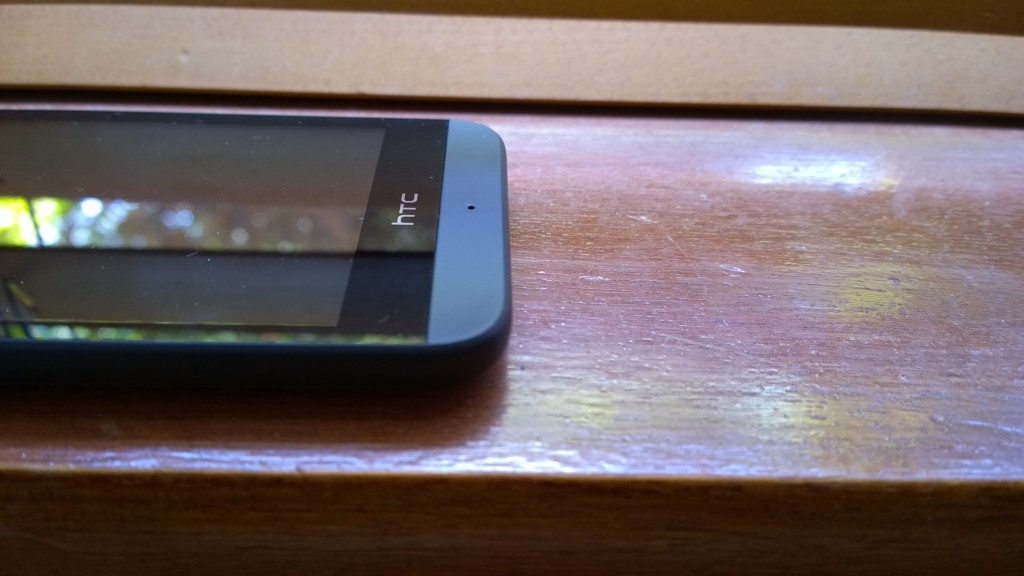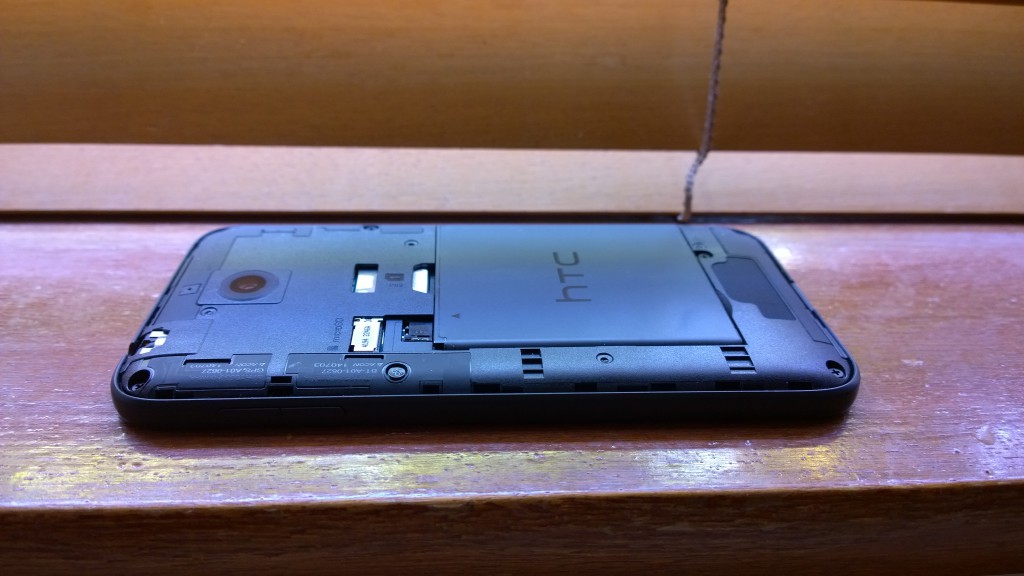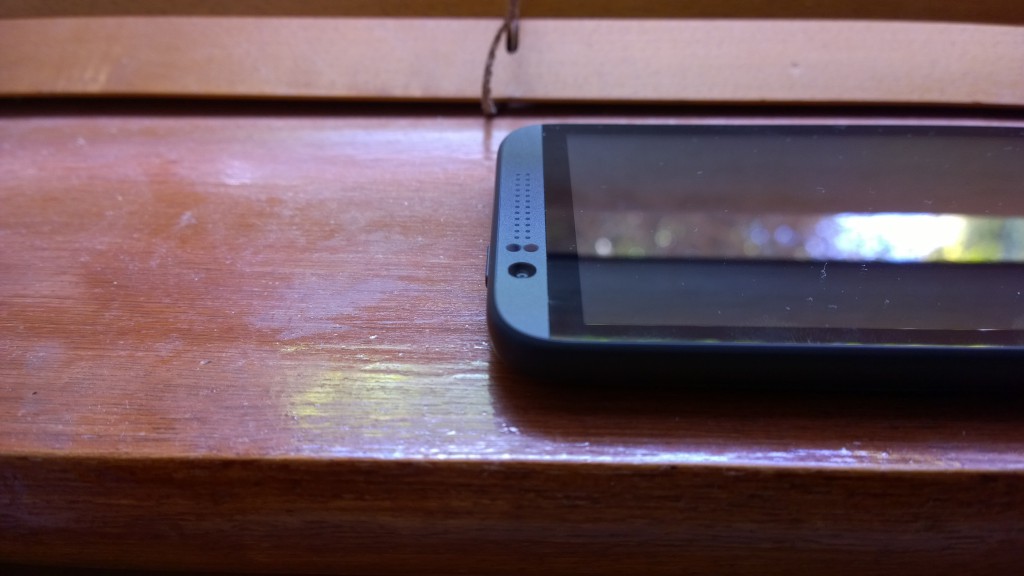
After the launch of their flagship device, the once venerable manufacturer HTC has continued its onward march of penetrating the smartphone market. Despite having one of the most adored phones of recent years in the HTC One, the Taiwanese company has a way to go in maintaining their growth, and the other devices in their portfolio are key to this. Following the launch of the Desire 816 and Desire 610 earlier this year, we now have the Desire 510 on our review bench, ready to attack the low-end of the market.
HTC has a budget phone with 4.7-inch display in the Desire 510, and the special distinction of being the first phone to market with the new 64-bit CPU from Qualcomm, the Snapdragon 410. Included in the box is the standard fare of 240V/200mAh mains charger, microUSB cable and a basic set of earbuds. HTC has implemented the most friendly charger I have seen to date, with the port for the microUSB cable located in the centre and not the sides of the charger. No more fighting for spare non-obstructed powerpoints!
Telstra has an exclusive on the Desire 510, and it is only available as a pre-paid handset for $179, in dark grey and white colours. Despite HTC listing the device at a RRP of $249, we have only seen it advertised unlocked elsewhere on UniqueMobiles for $178.
With the lower range becoming increasingly crowded with devices from competitors such as Alcatel and LG, does the HTC Desire 510 have what it takes? Read on to find out.
- 4G LTE connectivity at a low price
- Stellar battery life
- Stable, fast performance
- Mediocre display
- Somewhat clunky build
- Middling camera output
- Weak speakers – BoomSound advocates need not apply
Hardware
With the Desire 510, HTC has equipped the device with an unusual choice of CPU, the Snapdragon 410. From previous benchmarks we have seen, there is only a marginal increase in performance over the familiar Snapdragon 400. This is still a commendable choice though, as the processor breezes through everyday tasks.
The screen comes in at 4.7-inches in diagonal, which is about the par for this price range, however it only has a pixel density of 208 pixels per inch (PPI), which is on the low side. Fortunately, in contrast to its older siblings, the Desire 510 has a removable battery, which will tick the box in many folks’ eyes.

Finally in the last of its main features, there is a 5MP rear-facing camera with no LED flash, which has the potential to hurt its imaging capabilities. We will expand more on the above points below, so stay tuned.
Build Quality
The Desire 510 is made of plastic, and its design on the front and back echo its older siblings in the Desire 610 and Desire 816. On the front, we have an earpiece grill and front-facing camera/ambient light/proximity sensor layout mirroring other current devices in the HTC line-up. The back contains the 5MP rear-facing camera, speaker grill at the bottom and the HTC logo emblazoned in the centre.
Turning to the port and button placement, we have the power /lock key located on the top left edge of the phone, with the 3.5mm headphone jack on the right side of the top edge. The top right side is adorned with the volume up and volume down keys, and the microUSB port is located on the bottom right edge of the device. No buttons or ports are contained on the left edge of the Desire 510.

HTC’s proven track record with the rigidity of their device construction is maintained here, with absolutely no flex on show, even with the attachment of the back (removable) cover. Where the Desire 510 does fall down however is its sizeable heft, and this is something that you notice immediately upon picking it up for the first time. The HTC One and other phones in the stable are already known to be on the tall side dimension-wise, and the fact that the phone clocks in at 158 grams does not help proceedings either. We found our wrists tiring after an hour or so of use with the phone.
As being a budget phone does not ensure the provision of an oleophobic coating, it is no surprise that the Desire 510 is a fingerprint magnet. Fortunately, the matte build of the phone means that only the screen suffers as a result. One objection that we found is the use of an upside down microUSB port. A strange decision in 2014, certainly.

Overall, while not setting the world on fire with its looks, the consistency of design across the HTC portfolio does make the Desire 510 look and feel durable and that it can be trusted.
Screen
Upon handling the Desire 510, one is greeted with a 4.7-inch display of 854×480 resolution, landing a PPI value of 208. It has been quite a while since we have seen an Android phone here at Ausdroid with this low a pixel density. Clarity is an issue here with not only text, but images and general usage of the phone. The screen also shows up disappointing viewing angles with even the slightest of shifts, resulting in rapid loss of contrast. Colour reproduction also sides with inaccuracy here, with overly cool tones to images and whitespace, and sadly no colour adjustment options are on board to offer screen calibration.
There are quite sizable bezels to the display, but not enough to be a nuisance. At such a price range, slim bezels are not to be expected, and the only misgiving we have is with HTC’s typical style of having the top and bottom bars adding unnecessary height to an already tall device.
As the Desire 510 does not have an oleophobic coating, it is a fingerprint and dust magnet. Fortunately, the build quality is solid and dust does not seep into the edges of the device or underneath the display. These fingerprints do however leave a lasting impact on the visibility of the screen in direct sunlight, which due to the quality of the panel itself, is quite poor. We struggled with seeing anything on the overly reflective display on a sunny day,even with screen brightness output at maximum. The ambient light sensor can also be overly sensitive at times, constantly adjusting the display brightness when it is not required.
All being said, the display is the weakest part to the HTC Desire 510. However, as it is one of the more expensive components of the phone (and considering the price and target range the device is aimed at), this is an understandable move on behalf of the manufacturer.
Battery life
Where the Desire 510 stands out is in its battery life performance. The Snapdragon 4xx platform has been benchmarked and known in a lot of circles for being very miserly with battery life. Although seemingly low on paper with only a 2100 mAh capacity battery, the phone does not need to power a 720p or 1080p display, therefore battery life is greatly increased.

In our testing with the device, we spent a few minutes each day on phone calls, light levels of web browsing and YouTube, medium levels of texting and heavy usage of Twitter and Facebook over 4G LTE. After unplugging at 12pm two days previously, we finally made it to 20% of battery life remaining two days and three hours later. This is with the Power Saver mode turned on, which enables the user to select whether to conserve CPU usage, display brightness, vibration and data connection. Even with these optimisations turned on, the responsiveness of the device was not visibly affected in any way. HTC’s now familiar Extreme Power Saving mode also makes an appearance here, should a user require it. With sparing use of the Desire 510, you’re looking at three to four days of battery life, and at least a day with very heavy usage.
Perhaps the only downside that we found to the Desire 510’s battery is its rather slow charge time. With the included 1A wall charger and the battery at 15% capacity, the Desire 510 reached full charge approximately three hours later.
Camera
The Desire 510 comes with a 5MP main camera with no auto-focus and a front-facing camera of 0.3MP output. Neither are anything to write home about, but are about par for the course at this price range.
During the daytime and in the shade, the Desire 510 often came out with acceptable shots. Details while not always crisp, were discernable and there weren’t too many instances of compensatory oversharpening. Colours were often muted though, something that also translated to indoor shots. The lack of auto-focus or any kind of image stabilisation hurts the Desire 510’s photos here, as shots often dance with blurriness here.
When it comes to night shots, photos came out almost unusable, exhibiting extreme contrast and exposure inaccuracy, with large amounts of noise and smearing to compensate for the lack of detail. These characteristics also carried over to the front-facing camera, which has a rather low capability of only 0.3MP. The lack of even a basic LED flash on the Desire 510 really hurts the output for those wanting to capture shots at night.

Video is where the Desire 510 has a nice surprise, with 1080p capture capability. As shown by the video below, colours are satisfactory and exposure shifts are faster than expected. Some detail gets lost in the mix, but this should be enough to satisfy the majority of buyers out there.
Despite the above, it is nice to see HTC implement its full suite of camera functionality on the Desire 510. There are settings on board for different shooting modes, ISO and exposure adjustment, white balance and some fun shooting overlay effects. Due to the low output of the camera, for most shots these are somewhat of a novelty. For the fun factor however, they serve a nice purpose. Performance of the camera is very pleasant though, with a fast saving time and low shutter lag, which is nice to see.
Overall, the 5MP camera on the Desire 510 will get the job done, and at this price nothing more or nothing less should be expected. This will align with most consumers’ expectations and use of the Desire 510 anyway.
Connectivity
With the Desire 510, we have a tri-band 3G and tri-band 4G LTE device (of 800/1800 and 2600MHz bands). herefore the phone should play nice with Vodafone, Telstra and Optus’ 4G networks as well, although there is no support for the newest LTE roll-out on the 700MHz bands, nor support for the 4G+ Optus network which is required for Canberra residents desiring LTE on that carrier. Something to keep in mind if you value being a speed demon.
Bluetooth 4.0 and A-GPS with GLONASS are also on board. Both work quite well in data transfers, and usage of Google Maps and HERE Maps respectively.
Connectivity is rounded out with the presence of WiFi b/g/n, which worked very strongly and reliably in our time with the device. Unfortunately there is no support for the 5GHz band which can offer higher throughput of data.
Sound
Present on the bottom of the back of the Desire 510 is a speaker grille, that does not have HTC’s signature BoomSound capabilities. This phone is the only device in HTC’s 2014 line-up that does not have BoomSound, and performance suffers as a result. Sound is also easily muffled by fingers on a hand when holding the phone in landscape mode to watch videos or play games. The speaker also crackles unpleasantly at higher volumes.

Things don’t improve much when a set of headphones are plugged in. Sound is muddy and lacking bass, and the lack of any on-board effects or an equaliser hurts the standing of the Desire 510 in the sound department.
Performance
As alluded to earlier, the 1.2GHz Snapdragon 410 processor in the Desire 510 flys through everyday tasks. HTC’s minmialist Sense UI also helps proceedings here, as the performance feel is akin to using stock Android. We noticed no slow-downs while dragging down the notification shade, entering the device settings menu or using the launcher. HTC should be commended on having such a strong showing on their Android devices, as even with all the software features on board, performance is super slick and fast.
Optimisations HTC have made also translated to the loading times of apps and games. We did not notice any delays whilst opening apps such as Twitter and Facebook, and scrolling was consistently smooth, even with large cached operations. Games also were enjoyable with no stutter or lags experienced in the time we played Red Bull Air Race. The Desire 510 scored a very respectable 1255 on the GeekBench 3 benchmark test, showing that it is quite adept at its overall day-to-day performance.
The Snapdragon 410 processor is an interesting choice for HTC, so far it’s been heavily under-utilised by manufacturers, though as Qualcomm’s first 64-bit mobile system on a chip, it’s optimised for Android 5.0 if HTC decide to make that jump. HTC has been fairly vocal regarding their Lollipop plans for the flagship HTC One M7/M8, but the Desire range has so far seen less publicity on that front.
Software
HTC has moved leaps and bounds in the last couple of years with its move to a cleaner interface design and performance-optimised skin. These were reserved for the flagship device at first (the HTC One), but has moved down to the ranks recently to devices such as the Desire 816 and Desire 510. What we have here is pure, unadulterated HTC Sense UI 6.
Android OS
Out of the box, the Desire 510 comes loaded with Android 4.4.3. HTC has made the distinction of loading the optimisations and fixes found in Android 4.4.4 into its Android 4.4.3 update. So far, HTC has remained mum on the status of the Android 5.0 Lollipop update for many of the other handsets in the Desire range. HTC has a proven track record for releasing new Android updates within 90 days to its flagship devices, and this has trickled through to its mid-range phones, so we can all but hope that there is continued future support for the Desire 510.
Skins
Sense UI 6 is definitely something that needs to be used to be appreciated. HTC has pulled out all the stops in ensuring that everything functions as logically and smoothly as it should. The interface has elements that are clean and consistent in HTC’s own design language. Although differentiated from stock Android, HTC’s Sense UI feels just as fresh and fluid.
A pertinent example of this is the app drawer, which has organisation options listed prominently in the top left hand corner. Having the ability to customise the list of apps by most recent or alphabetical is a great help to those of us that have many apps installed on our Android devices.
One of the areas where HTC hasn’t messed with a great formula is in the Quick Settings menu (in the notification shade) and Settings menu. These are the areas of the UI where Sense most resembles stock Android and we can’t say that there is anything wrong with that fact.
The marquee feature of HTC devices is the presence of BlinkFeed, accessed by swiping right on the home screen. As it name says, this is an aggregate of news feeds and social media feeds, customisable for sources within the app itself. Although this emulates the functionality of apps such as Flipboard, we did not feel the need to install any similar apps on the Desire 510. Having news headlines and key interactions of your friends on social media displayed, is a very nice feature to have. Much like the rest of the UI, BlinkFeed does not slow down the device at all in loading or scrolling, which cannot be said for other manufacturers’ devices.
Bundled Apps
Installed on the HTC Desire 510 are a plethora of apps developed by HTC. With the basics of Clock, World Clock, Alarms and Stopwatch, these are nicely designed and adorned with beautiful animations. The pleasant design also extends to the Weather, Tasks, FM Radio and Voice Recorder apps that have been skinned by HTC.
The exclusive apps on board include Car, HTC Backup, HTC Dot View, HTC Guide and Parent Dashboard. Car is a simple app that once operated, turns your phone into a view with giant buttons for common operations, turning phone usage into a safer scenario while driving. HTC Backup and HTC Guide operate as the names suggest, the former providing backup of the phone’s settings (in case you replace or upgrade your phone), and the latter a support and user guide. Parent Dashboard locks the phone down so that certain areas and apps are unable to be accessed by children, and HTC Dot View provides support for the Dot View case. First seen with the HTC One M8, the Dot View case gives notifications in an old 8-bit graphical style, so we are surprised and excited to see this be supported on a low-end device like the Desire 510.
Overall, the addition of these apps by HTC solidifies an already exemplary software experience on the Desire 510.
- 4.7” FWVGA 854×480 (208 PPI)
- Qualcomm Snapdragon 410 Quad-core @ 1.2 GHz
- Adreno 306 GPU
- 1GB RAM
- 8GB storage (3.73GB available out of the box), microSD expandable up to 128GB
- 5MP rear-facing camera, 0.3MP front-facing camera
- WiFi b/g/n, Bluetooth 4.0, GPS/GLONASS
- Cellular radios:
- GSM: 850/900/1800/1900 MHz
- WCDMA: 850/900/2100 MHz
- 4G LTE: 800/1800/2600 MHz
- microSIM
- Android 4.4.3
- 2100 mAh battery
- 139.9 x 69.8 x 9.9mm, 158g
At the price point of the HTC Desire 510, there is not much other 4G capable phone competition save for the Alcatel Pop S3. Despite coming in at a good thirty dollars cheaper on the Optus network. Alcatel has a decidedly smaller screen and lower brand awareness than HTC. urn to Vodafone and you have the Samsung Galaxy Ace 3 coming in at the same price, and the Huawei Ascend Y550 undercutting the competition for only $99.
The ace up the sleeve of the Desire 510 is Sense UI 6 and its software features. HTC has done an exceptional job at providing a pretty and consistent user experience that merely sips at the bowser of battery life.
Many users will be looking for a cheap phone and won’t be wanting to fork out the extra $100 in cash for solid devices such as the Motorola Moto G. As such, if you can move past the screen quality of the Desire 510, this is a solid device that will keep you happy for many years to come.




























Thanks guys, glad you enjoyed the review as much as I did writing it and reviewing it 🙂
Love how ausdroid writes reviews in detail no matter if that’s a high end or low end phones….. Keep going guys 🙂
@Work from home and earn $9000 a month… Start today and at end of this day you can already have first earnings… Easy job for everyone with a computer and basic internet knowledge…
Start here>
✒✒✒✒✒✒ www.reviews-247.com
Absolutely agree vijay
🙂